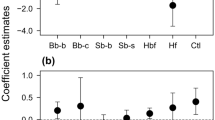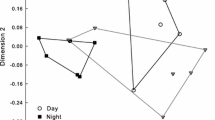Abstract
The effects of floral morphology on rates of pollen removal and deposition by different pollinators in generalist plant species are not well known. We studied pollination dynamics in wild radish, Raphanus raphanistrum, a plant visited by four groups of pollinators: honey bees, small native bees, butterflies, and syrphyd flies. The effects of anther position and other factors on pollen removal during single visits by all four pollinator taxa were measured. Flowers with high anther exsertion (i.e., anthers placed higher above the opening of the corolla tube) tended to have the highest numbers of pollen grains removed, but this effect was strongest for honey bees and butterflies. For all pollinator taxa, pollen removal increased with the number of pollen grains available on a flower and whowed a positive, decelerating relationship with the duration of the visit. The effects of stigma position and other factors on pollen deposition during single visits by honey bees and butterflies were also studied. The nectar-feeding butterflies had a higher pollination efficiency (percentage of pollen grains removed from anthers that were subsequently deposited on a stigma) than the nectar- and pollen-feeding honey bees. Flowers with intermediate stigma exsertion had the highest numbers of pollen grains deposited on their stigmas by butterflies, but stigma exsertion had no effect on deposition by honey bees. For both butterflies and honey bees, pollen deposition on the recipient flower increased with the amount of pollen removed from the donor flower, and there was a positive, decelerating relationship between deposition and time spent at the flower; these results are analogous to those for pollen removal. The effects of anther and stigma exsertion on pollen removal and denosition did not fit predictions based on patterns of floral correlations, but results for morphology, pollen availability, time spent per visit, and pollinator efficiency are in broad agreement with previous studies, suggesting the possible emergence of some general rules of pollen transfer.
Similar content being viewed by others
References
Alexander MP (1980) A versatile stain for pollen, fungi, yeast and bacteria. Stain Tech 55: 13–18
Barrett SCH (1992) Evolution and function of heterostyly. Springer, Berlin Heidelberg New York
Beattie AJ (1972) A technique for the study of insect-borne pollen. Pan-Pacific Entomol 47: 82
Brodie ED III (1992) Correlational selection for color pattern and antipredator behavior in the garter snake Thamnophis ordinoides. Evolution 46: 1284–1298
Campbell DR, Waser NM, Price MV (1994) Indirect selection of stigma position in Ipomopsis aggregata via a genetically correlated trait. Evolution 48: 55–68
Chambers JM, Cleveland WS, Kleiner B, Tukey PA (1983) Graphical methods for data analysis. Duxbury Press, Boston
Conner JK, Sterling A (1995) Testing hypotheses of functional relationships: a comparative survey of correlation patterns among floral and vegetative traits in five insect-pollinated plants. Am J Bot (in press)
Conner J, Via S (1993) Patterns of phenotypic and genetic correlations among morphological and life-history traits in wild radsh, Raphanus raphanistrum. Evolution 47: 704–711
Conner JK, Rush S, Jennetten P (1996) Measurements of natural selection on floral traits in wild radish (Raphanus raphanistrum). I. Selection through lifetime female fitness. Evolution (in press)
Darwin C (1877) The various contrivances by which orchids are fertilised by insects, 2nd edn. The University of Chicago Press, Chicago
Galen C (1992) Pollen dispersal dynamics in an alpine wildflower, Polemonium viscosum. Evolution 46: 1043–1051
Galen C, Stanton ML (1989) Bumble bee pollination and floral morphology: factors influencing pollen dispersal in the alpine sky pilot, Polemonium viscosum (Polemoniaceae). Am J Bot 76:419–426
Grant V, Grant KA (1965) Pollination in the Phlox family. Columbia University Press, New York
Harder LD (1990) Pollen removal by bumble bees and its implications for pollen dispersal. Ecology 71: 1110–1125
Harder LD, Barrett SCH (1993) Pollen removal from tristylous Pontederia cordata: effects of anther position and pollinator specialization. Ecology 74:1059–1072
Harder LD, Thomson JD (1989) Evolutionary options for maximizing pollen dispersal of animal-pollinated plants. Am Nat 133:323–344
Kay QON (1976) Preferential pollination of yellow-flowered morphs of Raphanus raphanistrum by Pieris and Eristalis spp. Nature 261:230–232
Kohn JR, Barrett SCH (1992) Experimental studies on the functional significance of heterostyly. Evolution 46:43–55
Levin DA, Berube DE (1972) Phlox and Colias: the efficiency of a pollination system. Evolution 26:242–250
Lloyd DG (1984) Gender allocations in outcrossing cosexual plants. In: Dirzo R, Sarukhán J (eds) Perspectives on plant population ecology, Sinauer, Sunderland, Mass, pp 277–300
Murcia C (1990) Effect of floral morphology and temperature on pollen receipt and removal in Ipomoea trichocarpa. Ecology 71:1098–1109
Neter J, Wasserman W, Kutner MH (1985) Applied linear statistical models, 2nd edn. Irwin, Homewood, III
Nilsson LA (1988) The evolution of flowers with deep corolla tubes. Nature 334:147–149
Rush S, Conner JK, Jenetten P (1995) The effects of natural variation in pollinator visitation on rates of pollen removal in wild radish, Raphanus raphanistrum (Brassicaceae). Am J Bot (in press)
SAS Institute Inc (1994) JMP, Ver 3. SAS Institute, Inc, Cary, NC
Scott JA (1986) The butterflies of North America. Stanford University Press, Stanford, Calif
Snow AA, Roubik DW (1987) Pollen deposition and removal by bees visiting two tree species in Panama. Biotropica 19: 57–63
Stanton ML, Snow AA, Handel SN (1986) Floral evolution: attractiveness to pollinators increases male fitness. Science 232:1625–1627
Stanton ML, Snow AA, Handel SN, Bereczky J (1989) The impact of a flower-color polymorphism on mating patterns in experimental populations of wild radish (Raphanus raphanistrum L.). Evolution 43:335–346
Stanton ML, Young HJ, Ellstrand NC, Clegg JM (1991) Consequences of floral variation for male and female reproduction in experimental populations of wild radish, Raphanus sativus L. Evolution 45:268–280
Stanton ML, Ashman T-L, Galloway LF (1992) Estimating male fitness of plants in natural populations. In: Wyatt R (eds) Ecology and evolution of plant reproduction, Chapman and Hall, London, pp 62–90
Webb CJ, Lloyd DG (1986) The avoidance of interference between the presentation of pollen and stigmas in angiosperms. II. Herkogamy. NZ J Bot 24:163–178
Wilson P, Thomson JD (1991) Heterogeneity among floral visitors leads to discordance between removal and deposition of pollen. Ecology 72:1503–1507
Wolfe LM, Barrett SCH (1989) Patterns of pollen removal and deposition in tristylous Pontederia cordataL. (Pontederiaceae). Biol J Linn Soc 36:317–329
Young HJ, Stanton ML (1990) Influences of floral variation on pollen removal and seed production in wild radish. Ecology 71:536–547
Author information
Authors and Affiliations
Rights and permissions
About this article
Cite this article
Conner, J.K., Davis, R. & Rush, S. The effect of wild radish floral morphology on pollination efficiency by four taxa of pollinators. Oecologia 104, 234–245 (1995). https://doi.org/10.1007/BF00328588
Received:
Accepted:
Issue Date:
DOI: https://doi.org/10.1007/BF00328588




